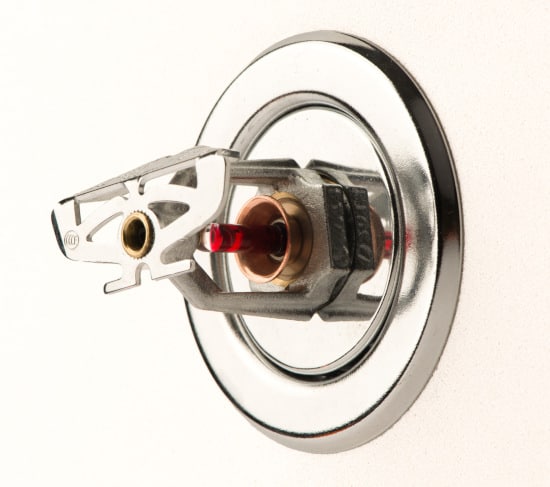A review of minimum and maximum distances between EC sprinklers and from heads to walls in NFPA 13
Extended coverage (EC) fire sprinklers do what the name says: provide more extensive coverage, typically allowing system designers to place fewer sprinklers in a given area. And with this capability, the sprinkler head spacing distance rules change.
Designers and installers must maintain certain minimum distances because putting sprinklers too close together is redundant and can impair effectiveness, as can placing them too far away. If a section of the wall needs to get wet to deprive a fire of its fuel source, for example, a faraway sprinkler will enable a blaze to spread and reduce valuable time to escape.
In part one of this QRFS series on sprinkler distances for extended coverage heads, we introduce some of the basic rules in NFPA 13: Standard for the Installation of Sprinkler Systems.
Check out QRFS’s selection of commercial fire sprinklers from leading manufacturers!
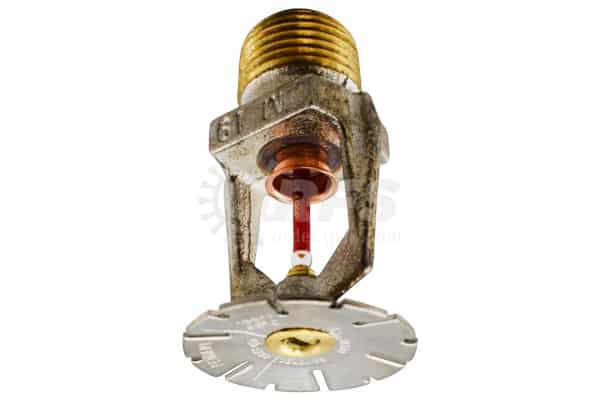
Sprinkler head spacing distances must be maintained to avoid setting off sprinklers late (or not at all)
NFPA 13 covers sprinkler distances in great detail, including those for standard spray, residential, early Suppression, fast-response (ESFR), control mode specific application (CMSA), and extended coverage (EC) models.
The NFPA 13 Handbook explains relevant distance and positioning considerations when specifically using EC sprinklers:
Many factors can influence the effectiveness of an extended coverage sprinkler installation, including the impact that construction and occupancy features have on sprinkler activation, the development of the sprinkler distribution pattern, and the presence of obstructions that could negatively affect or prevent water from reaching the hazard.
Further, it explains that the use of EC sprinklers “has increased dramatically” in the past decade, with the rollout of varying models appropriate for different hazard types and building uses, including “extra hazard occupancies and areas of high-piled storage.” And naturally, the sprinkler head spacing distance rules are a little different for extended coverage models, given the area over which they can spray water.
These specific distances ensure that sprinklers cover the design’s necessary area and that they don’t go off late or ineffectively. Sprinklers activate when the temperature around their heat-sensitive glass bulb or meltable fusible link gets high enough. But if a discharged sprinkler is too close to another sprinkler, the former’s spray could cool the air sufficiently to delay or stop the second head’s activation.
In addition, pockets of colder air can occur where walls join or connect with ceilings, affecting activation. Certain distance and obstruction rules aim to prevent this from happening.

Different systems and sprinkler types mean custom distance rules
Sprinkler head spacing distances between EC sprinklers and from an EC sprinkler to a wall are influenced by:
- Orientation. Rules geared toward upright, pendent, and sidewall extended coverage heads are covered in various sections of Chapter 11 in NFPA 13.
- Head characteristics. The design and performance of different fire sprinkler types—EC, residential, standard, and more—affect distance and obstruction needs. Chapters 10 through 15 cover all the possibilities and variations.
- Construction and occupancy type: Light hazard, ordinary hazard, extra hazard, and high-piled storage classifications each have specific rules, as do unobstructed or obstructed noncombustible construction categories (and sprinklers must be “specifically listed for such use,” in the latter case).
How the sprinkler system is designed also affects spacing; specifically, whether the layout relies on the pipe schedule method or hydraulic calculations.
Pipe schedule is when sprinkler density, unique hazards, and the water pressure are employed to determine a pipe size that hits the coverage and pressure requirements. This method is essentially outdated, however, and the vast majority of systems are now designed using hydraulic calculations. These systems rely on formulas accounting for water pressure, friction, elevation, and other factors that accurately meet how much pressure and flow the most challenging areas of a sprinkler system need.
As a general rule, the maximum allowable distance between sprinklers and between heads and walls are correlated—as one number goes up, so does the other.
Further complicating spacing is the presence of irregular walls, baffles on a sprinkler that may influence spray, vertical changes in ceiling elevation, and other varying ceiling types.
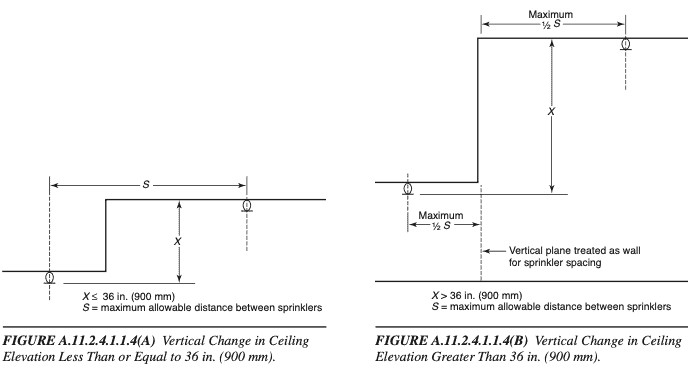
Maximum distances between standard upright and pendent sprinklers vary with a room’s hazards
For pendent and upright EC sprinklers, NFPA 13 establishes “Protection Areas and Maximum Spacing” for various hazard classifications using Table 11.2.2.1.2:
- Light Hazard (16 to 20 ft). Pendent and upright sprinklers in these environments have a 16- to 20-foot (4.9 to 6.1-meter) maximum distance in unobstructed construction types, depending on the specified protection area of between 256 ft2 (24 meters) to 400 ft2 (37 meters).
- Ordinary Hazard (12 to 20 ft.) Pendent and upright sprinklers have 12- to 20-foot (3.7 to 6.1-meter) maximum spacing, depending on unobstructed vs. obstructed construction types and the specified protection area of 144 ft2 (12 m2) to 400 ft2 (37 m2).
- Extra Hazard and High-Piled Storage (14-15 ft). Pendent and upright sprinklers both have a 14- or 15-foot (4.3 to 4.6-meter) maximum spacing for both unobstructed and obstructed construction types. 14 feet applies to a protection area of 196 ft2 (18 m2), and 15 feet applies to an area of 144 ft2 (13 m2).
The NFPA 13 Handbook explains special considerations for these latter two categories:
The limit of 196 ft2 (18.2 m2) for extra hazard and high-piled storage considers that fires in these occupancies develop much more rapidly than fires in light and ordinary hazard occupancies and can overtax adjacent sprinklers if one sprinkler fails to operate as anticipated.
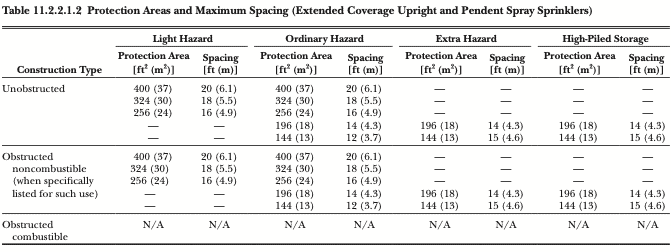
Minimum distances between standard upright and pendent sprinkler—head to head
First, the key to determining the right distance is measuring from the “center-line” vs. the edges. With that in mind, the basic rule is a minimum of 8 feet:
From the 2019 edition of NFPA 13
11.2.3.4 Minimum Distance Between Sprinklers.
11.2.3.4.1 Unless the requirements of 11.2.3.4.2 are met, sprinklers shall be spaced not less than 8 ft (2.4 m) on center.
The exception to this is when baffles are used. These disc-shaped devices help prevent spray from a sprinkler from cooling the temperature around another sprinkler, enabling closer spacing. They also safeguard the actuating elements of a sprinkler.
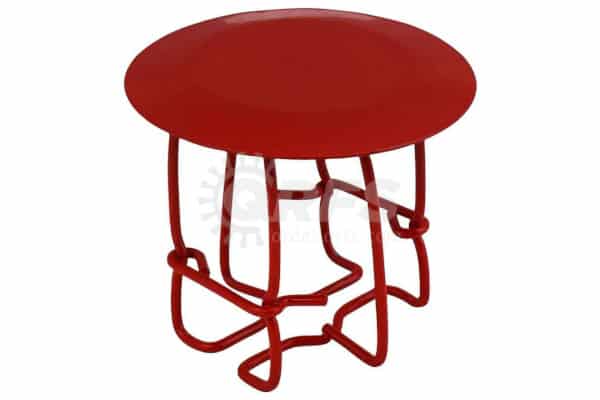
Sprinklers can get closer than 8 feet if they use baffles and the following conditions in section 11.2.3.4.2 are met:
- The baffles protect the “actuating elements.”
- The baffles are sturdy and remain “in place before and during sprinkler operation,” and they are at least 8 inches long and 6 inches high.
- Baffle tops “extend between 2 in. and 3 in. (50 mm and 75 mm) above the deflectors of upright sprinklers.”
- For pendents, their bottoms “extend downward to a level at least even with the deflectors.”
Maximum distances between sidewall EC sprinklers
Sidewall sprinklers that mount on a wall give system designers additional options for running vertical instead of horizontal pipe. This is especially helpful on the top floor of a building when the space above the ceiling lacks climate control, and wet pipes would freeze.
When it comes to sprinkler distance, the NFPA 13 Handbook explains that “extended coverage sidewall sprinklers have larger protection areas and flatter distribution patterns than standard spray sidewall sprinklers and, therefore, require greater separation distances from obstructions.”
As with other sprinkler orientations, the maximum distance relies on determining the protection area of coverage per sprinkler, which cannot be less than the sprinkler’s safety and performance listing. Regardless of the exact value, “the maximum area of coverage of a sprinkler shall not exceed 400 ft2 (37 m2).”
Just like the rules for other models, installers can’t measure EC sidewall sprinkler distances from the inside edges:
From the 2019 edition of NFPA 13
11.3.4.1.1 The maximum distance permitted between sprinklers shall be based on the center-line distance between sprinklers on the branch line along the wall.
11.3.4.1.2 Where sprinklers are installed along the length of a single wall of rooms or bays, they shall be spaced in accordance with the maximum spacing provisions of Table 11.3.3.2.1.
Also, the maximum distance must follow the following rules in sections 11.3.4.1.3 to 11.3.4.2:
- Sidewalls cannot “be installed back-to-back without being separated by a continuous lintel, soffit, or baffle.”
- They can “be installed on opposing or adjacent walls, provided no sprinkler is located within the maximum protection area of another sprinkler.”
- Ordinary-hazard areas permit a distance of only 10 feet (3 meters).
When it comes to the distance from walls, there is a limit of “one-half of the allowable distance permitted between sprinklers as indicated in Table 11.3.3.2.1.”

Minimum sprinkler head spacing distances between EC sidewall heads
The basic rule is that no sidewalls can be located within the maximum protection area of another sprinkler unless they are equipped with baffles, or there are special considerations regarding “kitchen cabinets, soffits, or other fixtures hang from the wall.” Again, baffles must comply with these guidelines:
(1) Baffles shall be arranged to protect the actuating elements.
(2) Baffles shall be of solid and rigid material that will stay in place before and during sprinkler operation.
(3) Baffles shall be not less than 8 in. (200 mm) long and 6 in. (150 mm) high.
(4) The tops of baffles shall extend between 2in. and 3in. (50mmand75mm) above the deflectors.
(5) The bottoms of baffles shall extend downward to a level at least even with the deflectors.
Minimum and maximum distances from walls and ceilings for pendent, upright, and sidewall extended coverage sprinklers
The minimum and maximum distances of different orientations from walls and ceilings vary.
Uprights and pendents
Upright and pendent EC sprinklers need a minimum clearance of one inch from a ceiling in unobstructed construction (11.2.4.1.1.1), excluding concealed, recessed, or flush models. With obstructed construction, things get complex:
From the 2019 edition of NFPA 13
11.2.4.1.2 Obstructed Construction. Under obstructed construction, the sprinkler deflector shall be located in accordance with one of the following arrangements:
(1) Installed with the deflectors within the horizontal planes of 1 in. to 6 in. (25 mm to 150 mm) below noncombustible structural members and a maximum distance of 22 in. (550 mm) below the ceiling/roof deck
(2) Installed with the deflectors at or above the bottom of noncombustible structural member to a maximum of 22 in. (550 mm) below the noncombustible ceiling/roof deck where the sprinkler is installed in conformance with 11.2.5.1.2.
(3) Installed in each bay of combustible or noncombustible obstructed construction, with the deflectors located a minimum of 1 in. (25 mm) and a maximum of 12 in. (300 mm) below the ceiling
(4) Installed in accordance with their listing where sprinklers are listed for use under other ceiling construction features or for different distances.
The minimum distance from walls for upright and pendent EC sprinklers is simple: “a minimum of 4 in. (100 mm) from a wall unless listed for distances less than 4 in.” (11.2.3.3).
Sidewalls
Sidewall EC models must be at least 4 inches (100mm) from an end wall and the ceiling, with the distance “measured perpendicular to the wall.” Note that there are specialized rules for the distance from the wall they are mounted on, the construction type, as well as when soffits are present:
11.3.5.1.1.2 Horizontal sidewall sprinklers shall be permitted to be located in a zone 6 in. to 12 in. (150 mm to 300 mm) or 12 in. to 18 in. (300 mm to 450 mm) below noncombustible or limited-combustible ceilings where listed for such use.
11.3.5.1.2 Walls.
11.3.5.1.2.1* Sidewall sprinkler deflectors shall be located not more than 6 in. (150 mm) or less than 4 in. (100 mm) from walls on which they are mounted. A.11.3.5.1.2.1 SeeA.10.3.5.1.2.1.
11.3.5.1.2.2 Horizontal sidewall sprinklers shall be permitted to be located with their deflectors less than 4 in. (100 mm) from the wall on which they are mounted.
The lintels and soffits rules are fairly complex and covered in detail in section 11.3.5.1.3.
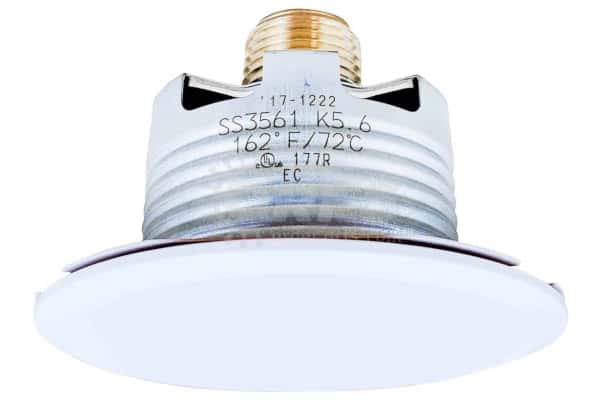
To be continued: NFPA 13’s rules on EC sprinkler head spacing distances
This concludes part one of our look at NFPA 13’s rules regarding maximum and minimum sprinkler head spacing distances for extended coverage models. Keep in mind that this is merely an introduction to the topic—the requirements get much more in-depth, especially those accounting for potential obstructions, irregular surfaces, clearance to storage, and more.
We’ll continue our examination in the next installment!
In the meantime, be sure to check out QRFS’s selection of commercial sprinkler heads!
Questions? Call us at +1 (888) 361-6662 or email support@qrfs.com.
This blog was originally posted at blog.qrfs.com. Visit us at Facebook.com/QuickResponseFireSupply or on Twitter @QuickResponseFS.



